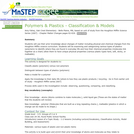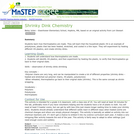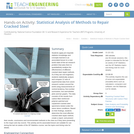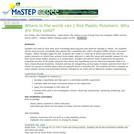
Plastics are very useful for the people and also it is equally hazardous
- Subject:
- Applied Science
- Environmental Science
- Material Type:
- Lecture Notes
- Author:
- F. Mary Priya
- Date Added:
- 05/03/2020

Plastics are very useful for the people and also it is equally hazardous

Experiments in this class are broadly aimed at acquainting students with the range of properties of polymers, methods of synthesis, and physical chemistry. Some examples of laboratory work include solution polymerization of acrylamide, bead polymerization of divinylbenzene, and interfacial polymerization of nylon 6,10. Evaluation of networks by tensile and swelling experiments, rheology of polymer solutions and suspensions, and physical properties of natural and silicone rubber are also covered.

This is an activity on polymers and plastics to expand our study of physical/chemical properties and changes.

Over several days, students learn about composites, including carbon-fiber-reinforced polymers, and their applications in modern life. This prepares students to be able to put data from an associated statistical analysis activity into context as they conduct meticulous statistical analyses to evaluate/determine the effectiveness of carbon fiber patches to repair steel. This lesson and its associated activity are suitable for use during the last six weeks of an AP Statistics course; see the topics and timing note for details. A PowerPoint® presentation and post-quiz are provided.

This activity is a hands-on activity where students learn about polymers and the science of plastics, while making shrinky dinks.

Students apply pre-requisite statistics knowledge and concepts learned in an associated lesson to a real-world state-of-the-art research problem that asks them to quantitatively analyze the effectiveness of different cracked steel repair methods. As if they are civil engineers, students statistically analyze and compare 12 sets of experimental data from seven research centers around the world using measurements of central tendency, five-number summaries, box-and-whisker plots and bar graphs. The data consists of the results from carbon-fiber-reinforced polymer patched and unpatched cracked steel specimens tested under the same stress conditions. Based on their findings, students determine the most effective cracked steel repair method, create a report, and present their results, conclusions and recommended methods to the class as if they were presenting to the mayor and city council. This activity and its associated lesson are suitable for use during the last six weeks of the AP Statistics course; see the topics and timing note for details.

The basic objective of Unified Engineering is to give a solid understanding of the fundamental disciplines of aerospace engineering, as well as their interrelationships and applications. These disciplines are Materials and Structures (M); Computers and Programming (C); Fluid Mechanics (F); Thermodynamics (T); Propulsion (P); and Signals and Systems (S). In choosing to teach these subjects in a unified manner, the instructors seek to explain the common intellectual threads in these disciplines, as well as their combined application to solve engineering Systems Problems (SP). Throughout the year, the instructors emphasize the connections among the disciplines.

This is a short lesson (including hands on activities) on polymers and plastics to expand our study of physical/chemical properties and changes.